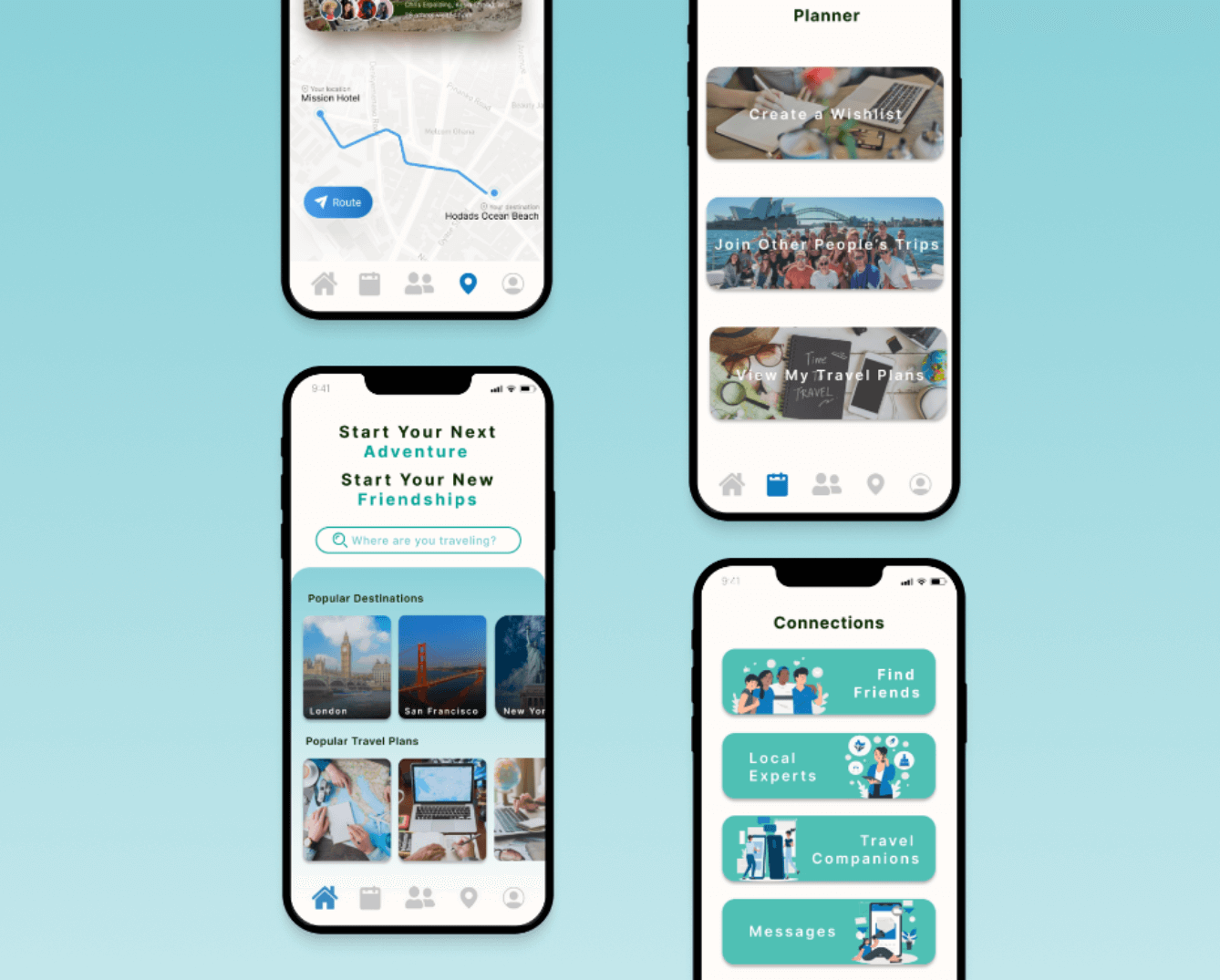
Link
High-Fidelity Prototype: tinyurl.com/yk8sdu3w
Problem
The travel planning process is difficult when there are multiple people involved.
Background
TripTogether is a mobile app that is designed to help travelers decide on where they want to go and what activities they want to do. Additionally, TripTogether helps travelers meet new friends who have similar interests.
However, TripTogether isn't just a mobile app; it's also a business. My team consisted of Kesin Chang, Yue Wang, Yucheng Zhang, Yanmin Mei, Christopher Erpelding, and I. We worked on this project for the class COGS 122: Startup Studio, so we considered many different factors that go into running a successful business. For example, we conducted a SET (Social, Economic, Technological) Analysis, analyzed the value that our product would bring to potential users, conducted A/B testing, created a 6-month budget and growth model, and even created a Kickstarter page.
I served as the leader for this team and my responsibilities as a leader included holding meetings, speaking on behalf of the team during presentations, and gathering feedback from Professor Steven Dow, who oversaw this project. During this project, I was very involved in researching the market of existing travel related products and services, which involved conducting competitive analyses, user interviews, and brainstorming different solutions. I was also heavily involved in writing the content for our promotional material, organizing the user flow and feature set of our product, and creating the financial plan of our simulated business.
Identifying User Problems and Pivoting
We originally didn't plan on designing an app that focused on collaboration and friend finding. We knew that we wanted to create a solution related to travel, but we first had to understand the challenges that travelers currently face.
We created an online questionnaire that asked questions about how extensively they plan their trips and the purpose behind their trips. Something else we were interested in was the tour guide industry, so we also asked a few questions about whether or not travelers hire tour guides.
Questionnaire Insights
- 74.6% of travelers said they make basic plans that are subject to change
- 98.4% of travelers don’t hire tour guides and a majority expressed that strict guides resulted in less freedom in travel planning
- 55.7% of travelers claim that their decision-making is greatly influenced by social media/online forums/YouTube and 37.7% claim that friends and families affect their decision-making the most
Storyboarding and Interviews
After seeing our questionnaire results, we created several storyboards to illustrate potential product ideas. We conducted further in-depth user interviews with respondents from our questionnaire and we also asked for opinions on our storyboards.
Our interviewees stated that they don't usually hire tour guides because they can do their own travel research online. They wanted to have freedom while planning their trips. The biggest takeaway that some of our interviewees mentioned was that it's difficult to plan trips together. They mentioned that they have to use services such as Google Sheets, which isn't designed for making travel plans.
After hearing our interviewees talking about how they do their own travel research, we decided that an app that simply provides the user travel information isn't a product that travelers need. However, a product that travelers do need is a travel-based collaborative planning tool, so we decided to pivot our efforts towards this new idea.
We found that our interviewees resonated with one of our storyboard ideas since it gave them information about landmarks without taking away their sense of freedom, but, since we had pivoted, we decided to put this idea on hold.

Setting Ourselves Apart From Competitors
Throughout the planning of our different product ideas, we compared ourselves to several informational travel apps, travel planning apps, and nontraditional traveling apps.
Something that we noticed about our competitors was that they didn't help people meet new travel companions and build new connections. We decided to separate our product from our competitors by incorporating a friend finding feature. TripTogether suggests travelers that have similar interests when you plan a trip. From there, you can view the profiles of the suggested travelers and add them to your friends list.
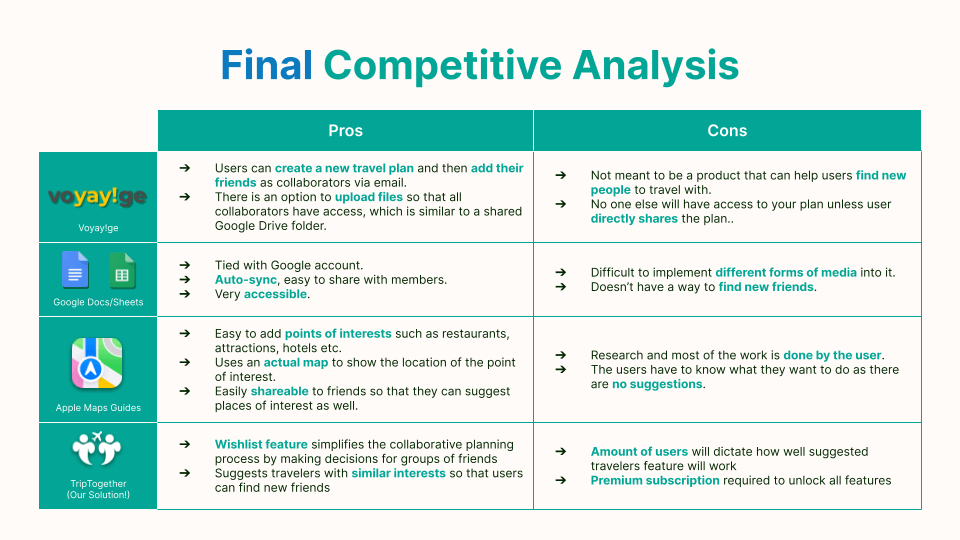
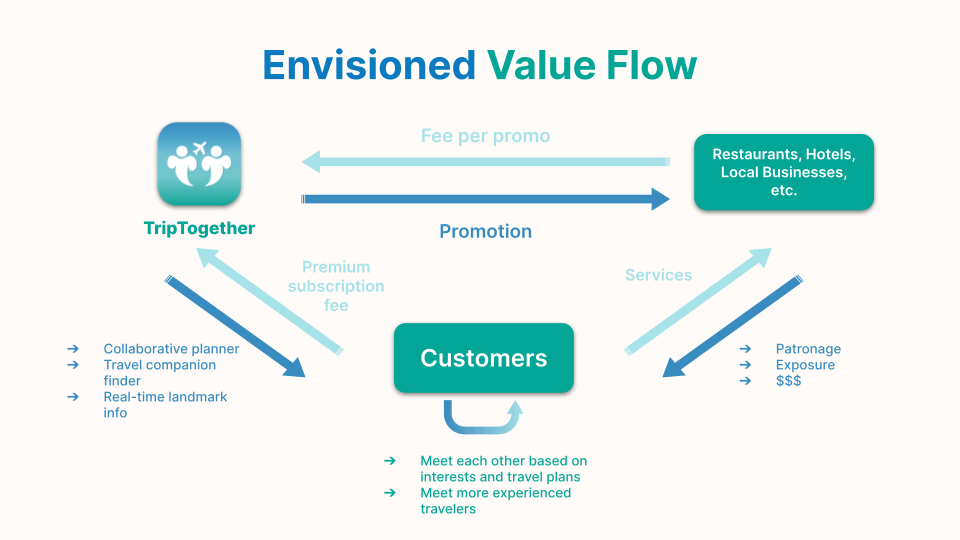
Web Probe
To see whether people would be receptive to our ideas, we created two landing pages -- one for our collaborative trip planning strategy and one for the friend finding features. By running a Google Ads campaign for each landing page, we conducted an A/B test. This was important to us because it told us which of our two core features we would need to focus on more.
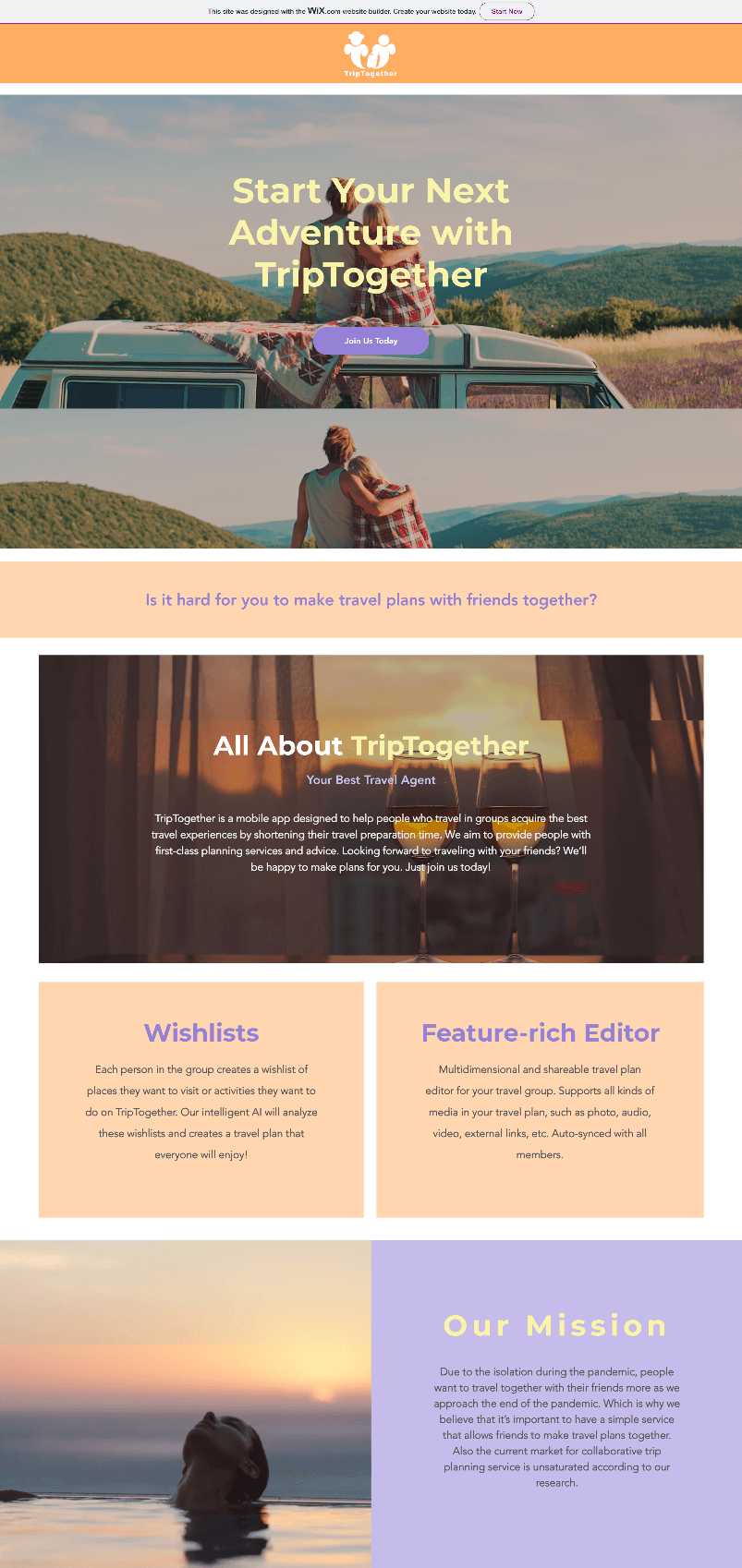
Collaborative Planning Landing Page

Friend Finding Landing Page
We found that our friend finding page had 15.4k impressions and 116 clicks while our collaborative planning page had 5.73k impressions and 69 clicks. The higher number of impressions indicates that people are searching for terms related to friend finding more than terms related to travel planning. The higher number of clicks means that travelers are more interested in finding companions to travel with.
This ended up influencing our final design because we decided to incorporate friend finding into our planner itself rather than keeping it a separate feature.
Final Design

Home Screen

Planner Screen

Connections Screen

Locations Screen
Trip Wishlist: Determining a Destination
Don’t know where you want to travel? Our wishlist feature includes a brief survey that asks you about types of environments and activities you’re interested in. TripTogether will then suggest of list of travel destinations that you’re sure to enjoy!
Trip Wishlist: Adding Activities
Don’t know what activities you want to do during travel? Our wishlist feature incorporates a “search for activities” function that allows you to add various kinds of activities you want to do during your trip to your wishlist.
Trip Wishlist: Generating a Plan
Don’t want to spend the time on making a trip plan? We will make a plan for you! Our algorithm will generate a travel plan based on the tags from the selected wishlists and trip plans uploaded by other users who have been to the same locations to give you the best recommendations!
Travel Companions
Don’t have a friend that is available to travel with you? Our suggested travelers feature allows you to find travelers that have similar travel destinations, interests, and personalities as you to make your trip not lonely anymore.
Budget & Pitch
In order to simulate how we would predict our budget and pitch our product to early customers, we created a Kickstarter page.
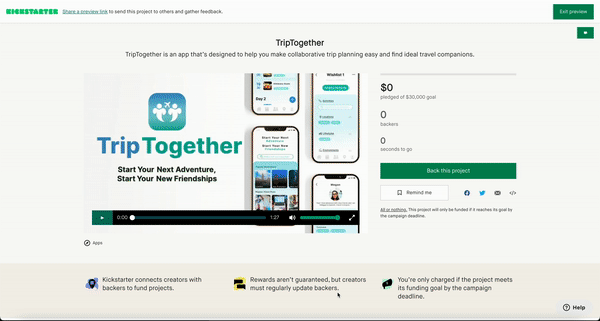
Our Kickstarter helped us determine the amount of initial income our startup would work with. We also had to figure out TripTogether would normally generate income. We decided to go back to the storyboard that our intial interviewees liked. We decided to make our Landmark Learner a feature for our premium service, which we would charge $5 a month for. Additionally, we decided that we would charge restaurants and other local businesses for promoting them to travelers.

As for our projected expenses, we had to consider what travel related rewards we would give to our backers and how we would create and ship these rewards. We also had to factor in the costs of hosting and promoting TripTogether. Finally, we had to consider how much we would spend on the salary for each employee. This was the largest expense for our company so we decided to minimize it by limiting our employees to just the 6 of us for the first six months of the launch of our product.

Since TripTogether is a travel app, we expected high growth during the summer months and the last few months of the year since those months are popular vacation months. However, this means that we also expected a dip in users during the month of September when people may not be traveling as often.

If you would like to see our full 6-month budget and growth model, you can see it here:
Reflection
While working on this project, my team had to meet many times a week in order to organize our thoughts and work together. In the beginning, since everyone had busy schedules that were difficult to work around, we had few meetings and fell behind on working on TripTogether. As a team leader, I decided that not everyone had to be present in order to hold a meeting. It was much better to hold a meeting with half the team than not have a meeting at all. As a result, we were able to distribute our work more evenly across the week and amongst ourselves.
During this project, I learned how important a business model and market research are to designing a successful product. What features do competitors have? How can your potential product get an edge over these competitors? What business models do your competitors operate on? Who is your target audience and what are they trying to gain from using your product? Will consumers be comfortable with your product's business model? Would consumers be willing to switch to your product from existing solutions? Will consumers find your product's features useful? These are a few questions that I ask myself during my design process now.
Something that I wish we were able to work on more was TripTogether's income generating services. We were able to decide how we would generate income, but I would've liked to prototype these features in more detail. I also would've liked to create more premium features to further encourage customers to upgrade to our premium plan.